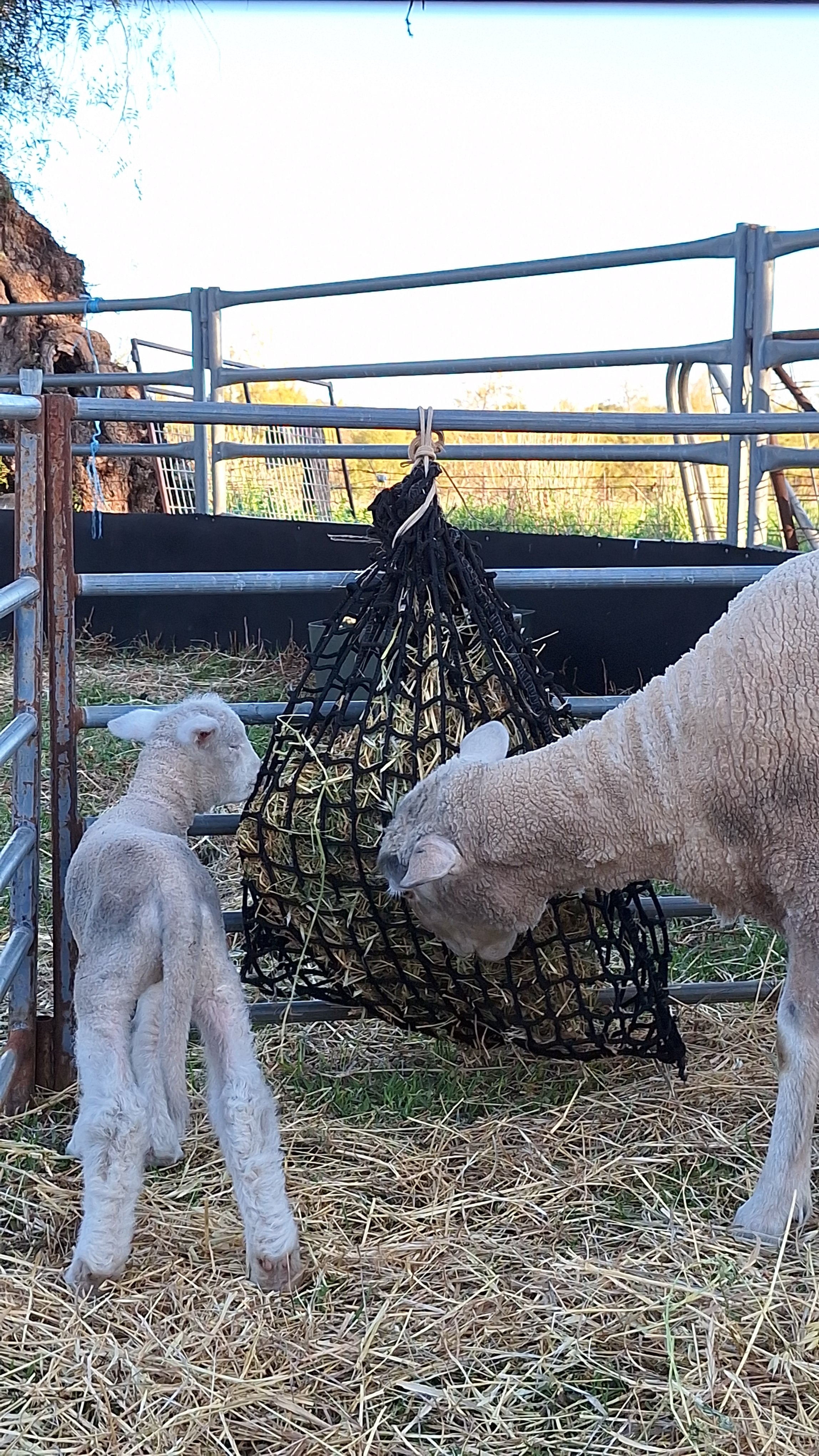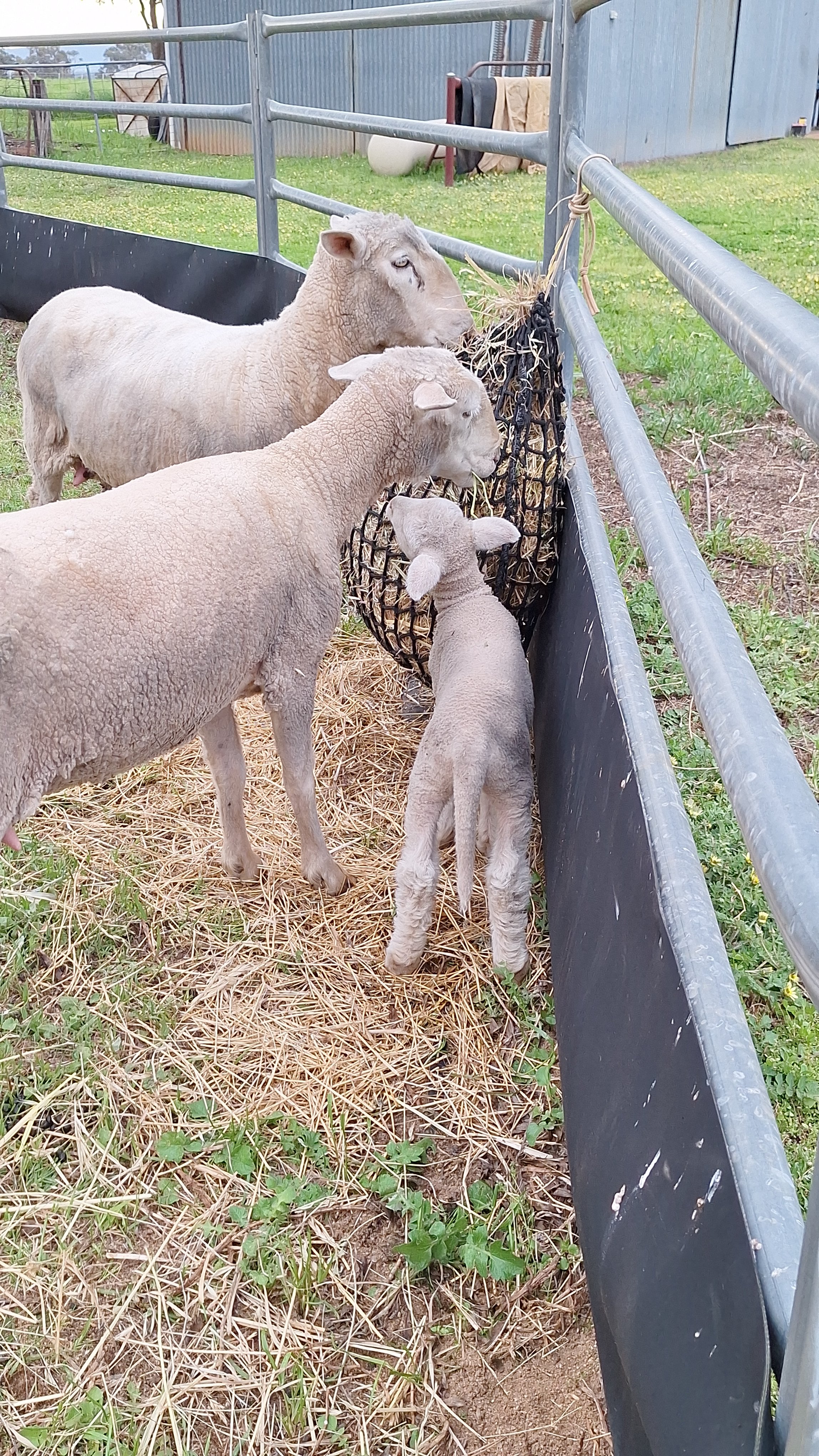Many people are now using our hay nets for all livestock. Although primarily used for horses, slow feed hay nets are increasing in popularity for assisting in managing livestock as well. Many parts of Australia have experienced a very dry winter and spring, therefore creating an issue of limited grass and feed availability. For many horse owners, and hobby farmers this has meant a reliance on hay far more than usual. However, livestock such as cattle, sheep, horses, donkeys, goats and alpacas aren’t known for their table manners and are quite happy to waste your expensive and precious hay, especially when it’s in a round bale or large export bale.
Cattle
Customers John and Alison from Newbridge (NSW, Australia) tried a GutzBusta Round Bale Net with their cattle and sheep.
Although there are other variables such as weather, time of year etc, but they were happy to report that putting a GutzBusta Slow Feeder Hay Net on their round bale made the bale last twice as long. There were 6 cows and 15 sheep with access and the bale still lasted until day 10. It was unclear if the sheep got a chance though as the cows were primarily around the bale.
Although there were no problems with the cattle being caught in the net, it would be advisable to put a steel feeding ring around the outer perimeter and then the round bale with the net on the inside of this ring. This will keep the cattle and their hooves from actually walking on the bale as it gets eaten down.


.jpg)
.jpg)
.jpg)
Please Note: Ear tags may be a problem for some cattle as they may rub them out, so you will need to assess if this will be a problem for your individual situation. Hobby farmers will find using our GutzBusta Hay Nets a godsend, however Stud Show Cattle owners may not wish to risk their cows ears being torn.
Alpacas
The owners of Lualto Alpacas kindly let us trial our nets with their livestock at the 2013 Murrumbateman Field Days. They were impressed by many factors, namely that the Alpacas were kept amused for a long time and also that they were not able to kick up and carry the hay around and then sit on it and use it as a toilet. Great to save on hay wastage.
These nets would be ideal for Alpacas, sheep and cattle in situations such as Field Days to keep the animals pens tidy, allow them access to hay all the time and also just keep the stock amused.
Pictured here using a 4cm (1 ¾”)Small Knotted GutzBusta Hay Net.


Donkeys
Donkeys absolutely love their hay and can be quite enthusiastic eaters, often pulling out and trampling more than they consume. Using a GutzBusta Slow Feed Hay Net helps slow their intake, keeps hay contained, and greatly reduces waste.
Many donkey owners have found that our 4cm (1 ¾”) hole size nets are ideal, allowing for steady feeding while keeping your hay contained and off the ground.
.jpg)



Sheep
Sheep are known for burrowing deep into hay bales in search of the tastiest bits, which often leads to trampling and unnecessary waste. Using a GutzBusta Hay Net helps keep hay clean, contained, and off the ground, reducing waste and keeping your flock happily munching for longer.
At our own farm, I personally use hay nets daily to feed our sheep and have seen firsthand how effective they are in keeping feed tidy and lasting longer. They’re simple to use, make feeding time stress-free, and keep the hay from being spread or soiled.
We recommend starting with a 4cm (1¾") hole size, or 3cm (1¼") if your hay is very palatable.
👉See our videos below for real examples of our sheep feeding from GutzBusta Slow Feed Hay Nets!






A recent conversation with a very happy customer reported that after using a 3cm (1 ¼) Round Bale Hay Net with her sheep, goats and alpacas, she has gone from going through 1 round bale ever week to the round bale lasting to between 5 and 6 weeks. The net therefore pays for itself very quickly.
Goats
Goats are clever, curious, and determined eaters, which often means hay gets pulled out, scattered, and wasted in no time! Using a GutzBusta Hay Net helps slow down their eating, keeps the hay contained and off the ground, and reduces waste dramatically.
For most goats, we recommend our 4cm (1¾") hole size, which allows for steady feeding without frustration. However, please note that if your goats have large or outward-facing horns, there’s a risk of them getting caught in any type of netting feeder. In those cases, use caution and consider whether a hay net is suitable for your setup.
Many hobby farmers have found these nets to be a game-changer for feeding efficiency and hay savings, keeping their paddocks cleaner and their animals busy and content.

.jpg)


Please Note: If your livestock have horns that netting could get hooked on, then we don't recommend using any type of netting slow feeders for these animals. Similarly, if your cattle have ear tags, then there is the possibility of them rubbing their heads and getting their ear tags caught and possibly ripping an ear, or losing the tag. It is therefore up to the owners discretion whether this product would be suitable or not. For hobby farmers, these nets are a god send.
For any specific questions or advice on your livestock setup, feel free to contact us, our team is always happy to assist.
We have a huge range of hay net hole sizes available and in order to help you with your decision on what hole size/s will best suit your livestock, we have more information here.
More Information about GutzBusta Hay Nets
- All GutzBusta hay nets are UV stabilised, they are tough and strong. They are created in a square mesh pattern which means that no matter how much or how little hay is inside the net, they are always easy to eat out of it, unlike diamond shaped holes that collapse down on themselves as the hay net empties.
- These nets have overlocked side stitching along the side seams to make them a tough and durable Hay Net. All nets have been designed by us and we have worked out the best sizes to suit Australian conditions. Developed and designed in Australia for the last 7 and thanks to customer feedback, we have produced a hay net superior to others available in Australia. They are very generous in sizing with wide mouths to allow them to be easily filled.
Caution:
- Shoes: If your horse is shod then simply tie your net up a little higher if it is a smaller net. If you are using a round bale or larger size net, then put your net inside a large box, hay ring or other device that stops their feet from coming into contact with their hay net. Direct contact of shoes and nets is not recommended.
- It is not recommended to leave buckled halters or other types of buckled headgear on your horse when using ANY type of hay net as your horse may get caught.
- Similarly, do not let horned animals such as cattle, sheep or goats eat from the nets due to possible entanglement.
- Cattle or stock with ear tags are cautioned from eating from the hay nets as they may rub their head and potentially remove the ear tags.
- It's important to keep in mind that horses wearing rugs might rub against the nets. To reduce the chance of a rug clip getting caught on the netting, make sure your buckles are properly secured and not sticking out, or consider securing the hay net to limit contact between the rug and the net. If rubbing is a concern, you might want to avoid having your horse wear a rug altogether.









